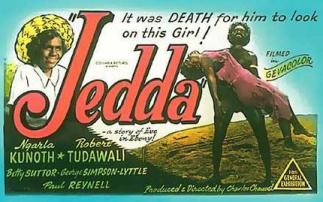Jedda (1955)

In Australian made productions, this was thefilm of the decade greasy ben came from veteran Australian director Charles Chauvel.
It was filmed in GevaColor – I have read that this system was very good for outdoor location colour filming so it would suit this film perfectly with most of the location work done in the Norther Territories around Darwin
Jedda was the story of an Aboriginal woman torn between two worlds. This film set many landmarks for Australian cinema: it was the first Australian feature film to employ Aboriginal actors (Robert Tudawali and Ngarla Kunoth) in leading roles, the first by an Australian director to be shot entirely in colour (the American-made Kangaroobeat it by three years to being the first colour feature shot in Australia), the first film to be invited to the prestigious Cannes Film Festival and probably the first film to take the emotional lives of Aboriginal people seriously.
Jedda was a vital first step on the road to White Australian society’s understanding of Aboriginal people. The film was fraught with difficulties, such as the loss of much of the film in a plane crash which necessitated the reshooting of the final scenes in the Blue Mountains instead of the Northern Territory.
The film received only mixed reviews and did not do well at the box office. This was the final film Chauvel made as he died four years later.

The Story :
An aboriginal cook from a Northern Territory cattle station dies giving birth. The child is subsequently adopted by the proprietors – the McManns’ – who have just lost their own daughter. The child is named ‘Jedda’, meaning ‘little wild goose’ and she is raised (as best Sarah can, yet against the pleaful wishes of her husband and coworkers) as a white girl (“bringing her closer to our way of life”), not knowing her own language or culture. Having learnt the piano, her A.B.C. and generally being taught how to behave a proper Australian woman, the polite girl soon comes to be greatly adored by all on the ranch. Yet come rainy season, when all her aboriginal friends ‘head bush’, Jedda regrets not being able to go with them.
Temporarily becoming a station-hand at the McManns’ Station is Marbuck – a nomadic, fringe-dwelling Aborigine – whom Jedda is strangely drawn to. His tribe still observes the traditional customs of the Dreamtime as they were at the time of White Settlement. To Jedda, Marbuck is a true and absolute representation of the culture that has, because of her upbringing, always been denied and outrightly repressed (both by her ‘parents’ and subconsciously, herself). However, when she is unexpectedly abducted by him, she is somewhat abhorred by the experience. When Marbuck brings his new bride before his tribal elders, he is non-too-politely asked to leave his ‘white’ wife. The two head off into the bush; Jedda uncertain what her fate will be and Marbuck undecided what action he will take.
In truth this is a film I have not seen – so much of this article is taken from other sites
I am now adding excerpts from the film showing just how good GevaColor is in these outdoor scenes – Very impressive indeed BELOW
Place your comment